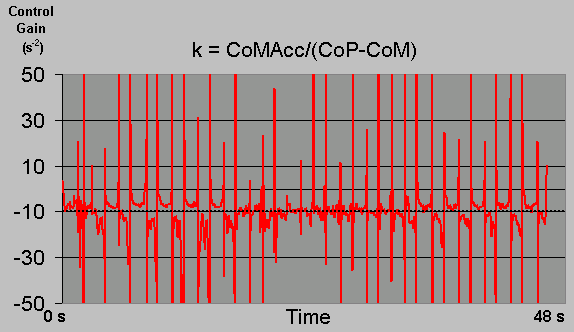 Teach-in
2001 : CoM & CoP during Rhythmic Weight-shifting
Teach-in
2001 : CoM & CoP during Rhythmic Weight-shifting
by Chris Kirtley, The
Catholic University of America, Washington DC
One fundamental component of the control of locomotion
is the ability to shift weight from one leg to the other. This is done
by using the Center of Pressure (CoP) to drive the total body Center of
Mass (CoM). In this experiment, a subject was asked to shift body weight
alternately from one foot to another in time with a metronome. Both feet
were on seperate force platforms, so that the individual and net CoPs could
be measured. The CoM was also calculated (at 60 fps) from a full body marker
set (Eames et al, 1999), and is shown by the long vertical
green line. The CoP is the small inverted 'T' on the floor. You can see
that they move sinusoidally pretty much in time with each other, but the
amplitude of the CoP is a little larger. Be patient loading the animation
as it's about 1.8Mb.

Winter (1995) suggested that the the CoM is related
to the CoP by
d(CoM) = k (CoP-CoM)
dt2
If the (CoP - CoM) difference is calculated (the CoMCoP:x
graph, low-pass filtered and inverted for clarity), you can see that it
does indeed resemble the CoM acceleration signal (CoMAcc). If we
plot CoMAcc/(CoP - CoM), we get:

It looks like the value of k (the gain of the postural
control system) is hovering around -10, but there are big spikes rather
regularly spaced through the data. Click on the chart to download the Excel
file (500kB) and have a closer look.
 Questions
Questions
-
What is causing these strange spikes?
-
Why are they regularly spaced?
-
How could you get rid of them?
-
Does k really represent the gain
of the postural control system?
-
Would you expect k always to be around -10?
-
in antero-posterior motion?
-
in different subjects?
-
in subjects of different heights?
-
in subjects of different body mass?
-
What does k represent in biomechanical terms?
Email your answers to [n/a] 
 What
we said on the CGA list
What
we said on the CGA list
Bibliography
Winter,
D.A. (1995) A.B.C. (Anatomy, Biomechanics, Control) of Balance during Standing
and Walking
Eames
MHA, Cosgrove A & Baker R. (1999) A Full Body Model To Determine The
Total Body Centre Of Mass During The Gait Cycle In Adults And Children.
Fifth International Symposium on the 3-D Analysis of Human Movement, Chattanooga,
Tennessee, USA, July 2 - 5, 1998
 Back to Teach-in page
Back to Teach-in page


![]() Back to Teach-in page
Back to Teach-in page